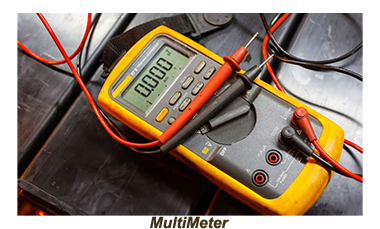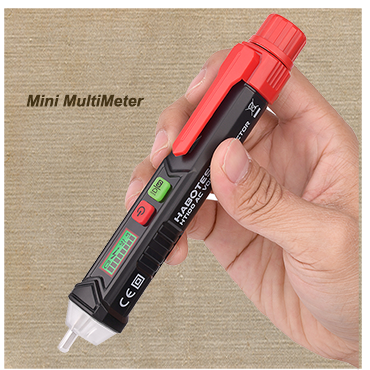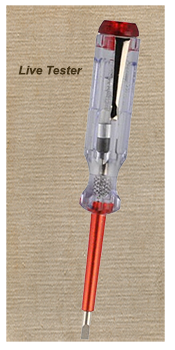
 The most obvious property of electricity is that it cannot be seen- for the good or the bad. Electric current can be quantified – meaning that by monitoring the levels of current flowing through a car's electrical system, it can be kept track of, hopefully eliminating any damages caused by power surges or current not being able to flow through the vehicle as it was programmed to do.
The most obvious property of electricity is that it cannot be seen- for the good or the bad. Electric current can be quantified – meaning that by monitoring the levels of current flowing through a car's electrical system, it can be kept track of, hopefully eliminating any damages caused by power surges or current not being able to flow through the vehicle as it was programmed to do.
At one time, two or three tools could be used to measure current flow in vehicle electrical wiring systems, each playing a separate role in diagnosing any problems encountered. The most commonly used were the voltmeter, which, as its name suggests, was used to measure voltage flow.
 A voltmeter is frequently helpful to measure the voltage at various stages of a circuit. Voltage can also be measured across a component to determine if there is a 'voltage drop.'
A voltmeter is frequently helpful to measure the voltage at various stages of a circuit. Voltage can also be measured across a component to determine if there is a 'voltage drop.'
Using a voltmeter makes it possible to rapidly detect a blockage, leak, or break in electric power flow continuity. All that needs to be done is touch the red probe from the meter to a live point using the black probe to earth. Another item of flow measuring equipment is the ohmmeter, used to measure current resistance.
Resistance levels can vary according to current flow and voltage. In order to measure objectively, the ohmmeter sends a known voltage current through the component or circuit in question and then measures the current as it returns.
 In recent years, advancement in auto electric technology has seen the arrival of the Multiple-Meter (multimeter), which can perform all of the functions that voltmeter and ohmmeter could do- and more.
In recent years, advancement in auto electric technology has seen the arrival of the Multiple-Meter (multimeter), which can perform all of the functions that voltmeter and ohmmeter could do- and more.
 There is a wide range of multimeters available, some but not all, dedicated to diagnosing auto-related problems. Another handy tool to have around is the basic live-tester: a lamp with a metal spike and an earth lead.
There is a wide range of multimeters available, some but not all, dedicated to diagnosing auto-related problems. Another handy tool to have around is the basic live-tester: a lamp with a metal spike and an earth lead.
By connecting the earth point and then waving the tip around so that this probe contacts, the lamp on the tester will light up When it comes to diagnosing electrical faults.
 This simple device is a gem of a tool to have on board, especially for classic car owners or drivers. Lots of electrical problems with older vehicles are caused by faulty connections. It is possible to narrow down problems quickly with the ability to trace where the power is flowing to and from.
This simple device is a gem of a tool to have on board, especially for classic car owners or drivers. Lots of electrical problems with older vehicles are caused by faulty connections. It is possible to narrow down problems quickly with the ability to trace where the power is flowing to and from.
To understand the functions of a multimeter or a live tester, it is essential to understand a little about voltage. There are two types of electrical current- AC which describes domestic current, while the current that flows through a vehicle's wiring system is DC.
Using a multi-meter set to check AC current in a vehicle will not have a harmful effect- it will simply do nothing. The multi-meter will spring into action and provide practical readings when set to DC.
 To test the voltage in the car battery, for example, the negative lead (black) should be attached to the negative battery terminal, and the positive lead (re) should be connected to the positive.
To test the voltage in the car battery, for example, the negative lead (black) should be attached to the negative battery terminal, and the positive lead (re) should be connected to the positive.
It is as simple as that.
With the multi-meter attached, a simple test to see if the battery is not holding its charge is to switch on the vehicle's headlights and leave them on for around a minute without the engine running.
At the end of the test period, the multi-meter should read around 12.8, showing that the battery has more or less fully charged. If the meter shows twelve or less, the battery will need to be recharged.
 The battery is obviously the centre of any vehicle's power generation system, and if it is sitting on 12 volts, it would be easy to assume that all is well.
The battery is obviously the centre of any vehicle's power generation system, and if it is sitting on 12 volts, it would be easy to assume that all is well.
It would be a false illusion to accept that, as there may be blockages anywhere in the complex wiring systems which could run for hundreds of meters within the vehicle, joined together by dozens of fuses.
A break or blockage can occur at any point, meaning that a vital function in the vehicle's system may not operate to its maximum capacity or not operate at all.
ae4

